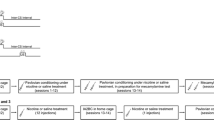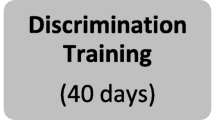Abstract
Although nicotine is a drug of abuse for millions of smokers, it has been difficult to demonstrate clearly the motivational properties of nicotine with rats using the conditioned place preference (CPP) paradigm. The first experiment attempted to replicate CPPs reported by other researchers using nicotine doses of 0.4, 0.8, and 1.2 mg/kg. There was a trend for all three doses to produce aversions, but it was significant only for the 0.8 mg/kg dose. Exposures to the CS alone extinguished aversions, but a “priming” dose (0.2 mg/kg) of nicotine given after extinction produced aversions only in animals exposed to 1.2 mg/kg. Experiment 2 tested whether preexposure to morphine or nicotine would sensitize animals to nicotine's reinforcing effects. In this experiment, rats were exposed to either six nicotine (0.6 mg/kg) or morphine (1.0 mg/kg) dosings prior to preference conditioning. Neither preferences nor aversions were observed in any group following subsequent conditioning with 0.6 mg/kg nicotine. The results suggest that previous observations of preference effects may have been due to specific procedural factors or may have depended on negative reinforcement due to stress reduction.
Similar content being viewed by others
References
Ashton H, Stepney R (1982) Smoking: psychology and pharmacology. Tavistock, London
Blumford HH, Cohen SD, Dronfield BE, Mordecai EA, Roberts JC, Hawks D (1974) British opiate users: I. People approaching London drug treatment centers. Int J Addict 9:1–23
Carboni E, Acquas E, Leone P, DiChiara G (1989) 5HT3 receptor antagonists block morphine- and nicotine- but not amphetamine-induced reward. Psychopharmacology 97:175–178
Clarke PBS, Fibiger HC (1987) Apparent absence of nicotine-induced conditioned place preference in rats. Psychopharmacology 92:84–88
Clarke PBS, Kumar R (1983) Characterization of the locomotor stimulant action of nicotine in tolerant rats. Br J Pharmacol 80:587–594
Clarke PBS, Pert A (1985) Audioradiographic evidence for nicotine receptors on nigrostriatal and mesolimbic dopaminergic neurons. Brain Res 348:355–358
Cohen J, Cohen P (1983) Applied multiple regression/correlation analysis for the behavioral sciences. Lawrence Erlbaum Associates, Hillsdale, NJ
Fudala PJ, Iwamoto ET (1987) Conditioned aversion after delay place conditioning with nicotine. Psychopharmacology 92:376–381
Fudala PJ, Iwamoto ET (1986) Further studies on nicotine-induced conditioned place preference in the rat. Pharmacol Biochem Behav 25:1041–1050
Fudala PJ, Teoh KW, Iwamoto ET (1985) Pharmacologic characterization of nicotine-induced conditioned place preference. Pharmacol Biochem Behav 22:237–241
Gionguieff-Chesselet MF, Kemel MF, Wandscheer D, Glowinski J (1979) Regulation of dopamine release by presynaptic dopamine receptors in the rat striatal slices: effect of nicotine in a low concentration. Life Sci 25:1257–1262
Gritz ER (1980) Smoking behavior and tobacco abuse. In: Mello NK (ed) Advances in substance abuse. JAI Press, Greenwich, CN, pp 91–158
Haertzen CA, Kocher TR, Mayasato K (1983) Reinforcement from the first drug experience can predict later drug habits and/or addiction: results with coffee, cigarettes, alcohol, barbiturates, minor and major tranquilizers, stimulants, marijuana, hallucinogens, heroin, opiates, and cocaine. Drug Alcohol Depend 11:147–165
Henningfield JE (1984) Behavioral pharmacology of cigarette smoking. In: Thompson T, Dews PB, Barrett SJE (eds) Adv Behav Pharmacol, vol 4. Academic Press, New York
Henningfield JE, Goldberg SR (1983) Nicotine as a reinforcer in human subjects and laboratory animals. Pharmacol Biochem Behav 19:989–992
Hunt WA, Bespalec DA (1974) An evaluation of current methods of modifying smoking behavior. J Clin Psychol 30:431–438
Keppel G (1982) Design and analysis 2nd edn. Prentice-Hall, Englewood Cliffs, NJ
Mittleman G, Castaneda E, Robinson TE, Valenstein ES (1986) The propensity for nonregulatory ingestive behavior is related to differences in dopamine systems: behavioral and biochemical evidence. Behav Neurosci 100:213–220
Mosbach P, Leventhal H (1988) Peer group identification and smoking: implications for intervention. J Abnorm Psychol 97:238–245
Mucha RF, Iversen SD (1984) Reinforcing properties of morphine and naloxone revealed by conditioned place preferences: a procedural examination. Psychopharmacology 82:241–247
Pert A, Chiueh CC (1986) Effects of intracerebral nicotine agonists on locomotor activity: involvement of mesolimbic dopamine. Soc Neurosc Abstr 12:250.4
Risner ME, Goldberg SR (1983) A comparison of nicotine and cocaine self-administration in the dog: fixed-ratio and progressive-ratio schedules of intravenous drug infusion. J Pharmacol Exp Ther 224:319–326
Robinson TE, Becker JB (1986) Enduring changes in brain and behavior produced by chronic amphetamine administration: a review and evaluation of animal models of amphetamine psychosis. Brain Res Rev 11:157–198
Schwartz B (1984) Psychology of learning and behavior, 2nd edn. WW Norton, New York
Sherman JE, Pickman C, Rice A, Liebeskind JC, Holman EW (1980a) Rewarding and aversive effects of morphine: temporal and pharmacological properties. Pharmacol Biochem Behav 13:501–505
Sherman JE, Roberts T, Roskham SE, Holman EW (1980b) Temporal properties of the rewarding and aversive effects of amphetamine in rats. Pharmacol Biochem Behav 13:597–599
Stewart J (1984) Reinstatement of heroin and cocaine self-administration behavior in the rat by intracerebral application of morphine in the ventral tegmental area. Pharmacol Biochem Behav 20:917–923
Stewart J, Eikelboom R (1987) Conditioned drug effects. In: Iversen LL, Iversen SD, Snyder SH (eds) Handbook of psychopharmacology vol 19. Plenum Press, New York.
Stewart J, Vezina P (1987) Environment-specific enhancement of the hyperactivity induced by systemic or intra-VTA morphine injections in rats preexposed to amphetamine. Psychobiology 15:144–153
Stolerman IP (1987) Psychopharmacology of nicotine: stimulus effects and receptor mechanisms. In: Iversen LL, Iversen SD, Snyder SH (eds) Handbook of psychopharmacology vol 19. Plenum Press, New York
Vezina P, Stewart J (1987) Conditioned locomotion and place preference elicited by tactile cues paired exclusively with morphine in an open field. Psychopharmacology 91:375–380
Westfall TC (1974) Effect of nicotine and other drugs on the release of3H-norepinephrine and3H-dopamine from rat brain slices. Neuropharmacology 13:693–700
Wickström B (1980) Cigarette marketing in the third world. In: Bamstrom LM (ed) The smoking epidemic: proceedings of the fourth world conference on smoking and health. Almquist and Wiksell, Stockholm
Wise RA (1988) The neurobiology of craving: implications for understanding and treatment of addiction. J Abnorm Psychol 97:118–132
Wise RA, Bozarth MA (1987) A psychomotor stimulant theory of addiction. Psychol Rev 94:469–492
Author information
Authors and Affiliations
Rights and permissions
About this article
Cite this article
Jorenby, D.E., Steinpreis, R.E., Sherman, J.E. et al. Aversion instead of preference learning indicated by nicotine place conditioning in rats. Psychopharmacology 101, 533–538 (1990). https://doi.org/10.1007/BF02244233
Received:
Revised:
Issue Date:
DOI: https://doi.org/10.1007/BF02244233




